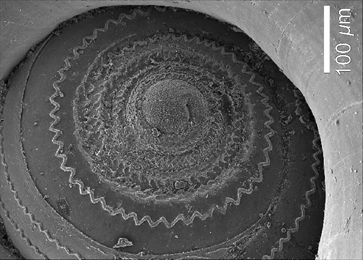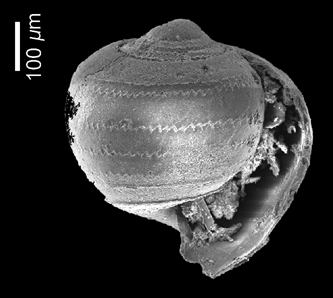Protatlanta Rotundata on:
[Wikipedia]
[Google]
[Amazon]
''Protatlanta rotundata'' is an extinct 

species
In biology, a species is the basic unit of classification and a taxonomic rank of an organism, as well as a unit of biodiversity. A species is often defined as the largest group of organisms in which any two individuals of the appropriate s ...
of sea snail
Sea snail is a common name for slow-moving marine gastropod molluscs, usually with visible external shells, such as whelk or abalone. They share the taxonomic class Gastropoda with slugs, which are distinguished from snails primarily by the ...
, a holoplankton
Holoplankton are organisms that are plankton, planktic (they live in the water column and cannot swim against a current) for their entire life cycle. Holoplankton can be contrasted with meroplankton, which are planktic organisms that spend part of ...
ic marine
Marine is an adjective meaning of or pertaining to the sea or ocean.
Marine or marines may refer to:
Ocean
* Maritime (disambiguation)
* Marine art
* Marine biology
* Marine debris
* Marine habitats
* Marine life
* Marine pollution
Military
* ...
gastropod
The gastropods (), commonly known as snails and slugs, belong to a large taxonomic class of invertebrates within the phylum Mollusca called Gastropoda ().
This class comprises snails and slugs from saltwater, from freshwater, and from land. T ...
mollusk
Mollusca is the second-largest phylum of invertebrate animals after the Arthropoda, the members of which are known as molluscs or mollusks (). Around 85,000 extant species of molluscs are recognized. The number of fossil species is e ...
in the family
Family (from la, familia) is a Social group, group of people related either by consanguinity (by recognized birth) or Affinity (law), affinity (by marriage or other relationship). The purpose of the family is to maintain the well-being of its ...
Atlantidae
Atlantidae is a family of sea snails, holoplanktonic gastropod molluscs in the clade Littorinimorpha.
According to taxonomy of the Gastropoda by Bouchet & Rocroi (2005) the family Atlantidae has no subfamilies.
Description
The Atlantidae is a ...
.


Description
The width of the shell can reach up to 10 mm. In the largest specimen there are almost twoteleoconch
The gastropod shell is part of the body of a gastropod or snail, a kind of mollusc. The shell is an exoskeleton, which protects from predators, mechanical damage, and dehydration, but also serves for muscle attachment and calcium storage. Some ...
whorls that initially attach very high onto the protoconch
A protoconch (meaning first or earliest or original shell) is an embryonic or larval shell which occurs in some classes of molluscs, e.g., the initial chamber of an ammonite or the larval shell of a gastropod. In older texts it is also called ...
, with the result that the larval shell seems to be embedded rather obliquely within the younger whorls. The diameter of the teleoconch increases rapidly, the result being a shell that strongly resembles '' Planorbarius'' (but, of course, dextral). The surface of these younger whorls bears flexuous growth lines, and a dense and very fine, somewhat irregular spiral striation, only visible where light reflects on the shell. On the body whorl
The body whorl is part of the morphology of the shell in those gastropod mollusks that possess a coiled shell. The term is also sometimes used in a similar way to describe the shell of a cephalopod mollusk.
In gastropods
In gastropods, the b ...
a distinct peripheral belt is present on which the growth lines are strongly bent backward, indicating a deep sinus in the apertural margin.
The larval shell is globular, about as wide as high and has approximately five whorls
A whorl ( or ) is an individual circle, oval, volution or equivalent in a whorled pattern, which consists of a spiral or multiple concentric objects (including circles, ovals and arcs).
Whorls in nature
File:Photograph and axial plane floral d ...
which attach very high onto the preceding whorl. In apical view, therefore, the second and third whorls are very narrow, even much narrower than the nucleus and first whorl of the protoconch
A protoconch (meaning first or earliest or original shell) is an embryonic or larval shell which occurs in some classes of molluscs, e.g., the initial chamber of an ammonite or the larval shell of a gastropod. In older texts it is also called ...
. The fifth whorl gradually attaches somewhat lower on the penultimate whorl. All protoconch whorls have a number of very narrow, distant and thread-like spiral lirae with a zigzag structure, just one of which remains visible between the upper and lower sutures. One spiral at the place of the suture and a further one on the base of the protoconch are somewhat stronger developed, but do not or only faintly show the zigzag structure. The boundary with the teleoconch is indicated by a rather sudden disappearance of the ornament.
''Protatlanta rotundata'' differs considerably from the type of the genus, ''Protatlanta souleyeti
''Protatlanta souleyeti'' is a species of sea snail, a holoplanktonic marine gastropod mollusk in the family Atlantidae.
''Protatlanta souleyeti'' is the type species on the genus ''Protatlanta''. It is considered to be the only Recent species ...
''. Not only does the adult shell in ''Protatlanta rotundata'' reach a diameter that is roughly five times that of ''Protatlanta souleyeti'', but the morphology of its protoconch and the shape of the fully grown shell are utterly different. Also, as both species occur together in the Pangasinan
Pangasinan, officially the Province of Pangasinan ( pag, Luyag/Probinsia na Pangasinan, ; ilo, Probinsia ti Pangasinan; tl, Lalawigan ng Pangasinan), is a coastal province in the Philippines located in the Ilocos Region of Luzon. Its capit ...
samples, ''Protatlanta rotundata'' can certainly not be considered to be the ancestor species. The presence of a subperipheral belt much the same as in ''Protatlanta souleyeti'', on the other hand, demonstrates that a conchiolin
Conchiolins (sometimes referred to as conchins) are complex proteins which are secreted by a mollusc's outer epithelium (the mantle).
These proteins are part of a matrix of organic macromolecules, mainly proteins and polysaccharides, that assem ...
keel has been present in this species.
Distribution
''Protatlanta rotundata'' was originally described from the (Late?)Miocene
The Miocene ( ) is the first geological epoch of the Neogene Period and extends from about (Ma). The Miocene was named by Scottish geologist Charles Lyell; the name comes from the Greek words (', "less") and (', "new") and means "less recen ...
of the Dominican Republic
The Dominican Republic ( ; es, República Dominicana, ) is a country located on the island of Hispaniola in the Greater Antilles archipelago of the Caribbean region. It occupies the eastern five-eighths of the island, which it shares wit ...
and has a wide horizontal and vertical distribution; Langhian
The Langhian is, in the ICS geologic timescale, an age or stage in the middle Miocene Epoch/Series. It spans the time between 15.97 ± 0.05 Ma and 13.65 ± 0.05 Ma (million years ago) during the Middle Miocene.GeoWhen (2007)
The Langhian was a ...
-Serravallian
The Serravallian is, in the geologic timescale, an List of time periods, age or a stage (stratigraphy), stage in the middle Miocene epoch (geology), Epoch/series (stratigraphy), Series, which spans the time between 13.82 annum, Ma and 11.63 Ma (m ...
(Italy, Malta, Cyprus; RGM collections), Tortonian
The Tortonian is in the geologic time scale an age or stage of the late Miocene that spans the time between 11.608 ± 0.005 Ma and 7.246 ± 0.005 Ma (million years ago). It follows the Serravallian and is followed by the Messinian.
The Torton ...
(Sicily), Piacenzian
The Piacenzian is in the international geologic time scale the upper stage (stratigraphy), stage or latest age (geology), age of the Pliocene. It spans the time between 3.6 ± 0.005 year#SI prefix multipliers, Ma and 2.588 ± 0.005 Ma (million yea ...
(Spain, Jamaica, Philippines), Pliocene
The Pliocene ( ; also Pleiocene) is the epoch in the geologic time scale that extends from 5.333 million to 2.58Anda, Pangasinan
Anda, officially the Municipality of Anda ( pag, Baley na Anda; ilo, Ili ti Anda; tgl, Bayan ng Anda), is a 3rd class municipality in the province of Pangasinan, Philippines. According to the 2020 census, it has a population of 41,548 people.
...
, Luzon, Philippines and ‘Middle Pliocene-Early Pleistocene
The Early Pleistocene is an unofficial sub-epoch in the international geologic timescale in chronostratigraphy, being the earliest division of the Pleistocene Epoch within the ongoing Quaternary Period. It is currently estimated to span the time ...
’ (Japan).
References
This article incorporates CC-BY-3.0 text from the reference. {{Taxonbar, from=Q7251193 Atlantidae Prehistoric gastropods Langhian first appearances Pleistocene extinctions Neogene animals of Oceania